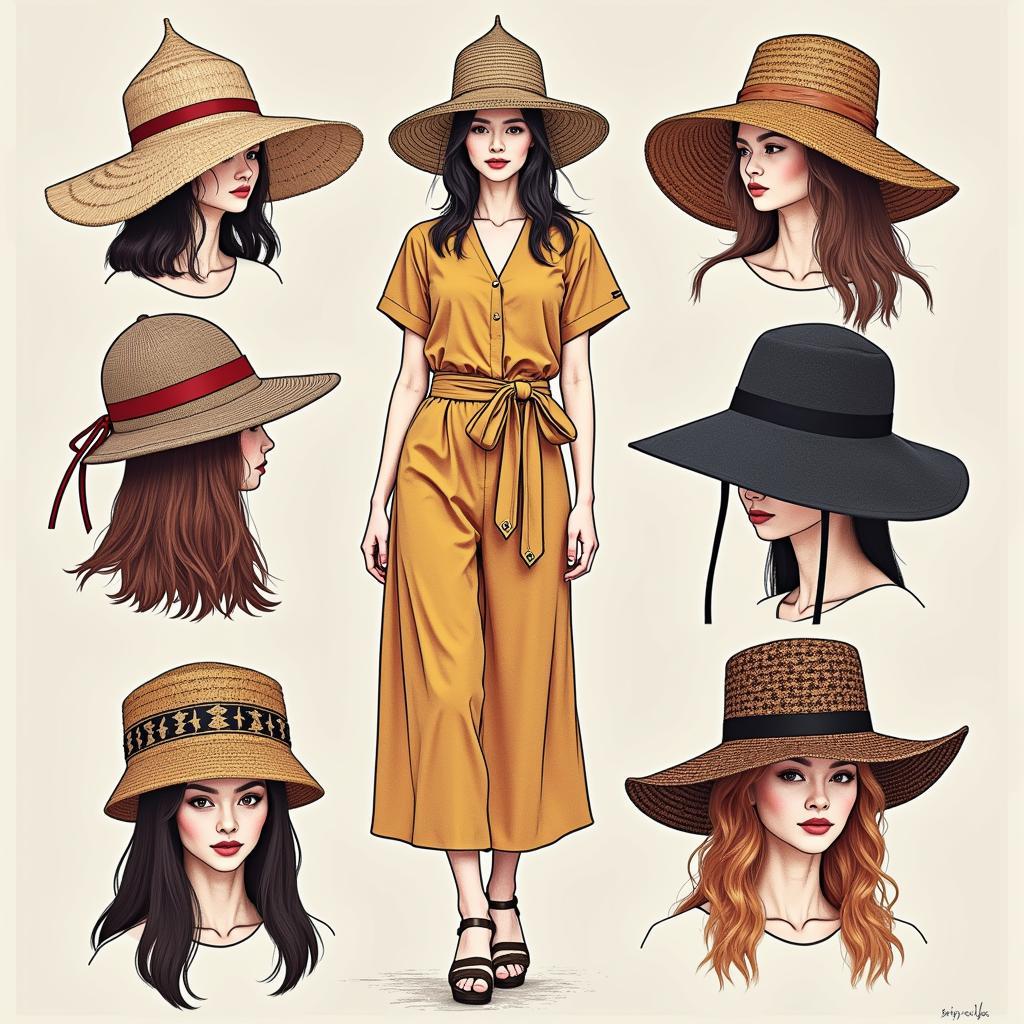ASEAN hats are more than just headwear; they’re vibrant symbols of culture, heritage, and identity. From the iconic non la of Vietnam to the elegant songkok of Malaysia, each hat tells a story, weaving together threads of tradition, artistry, and national pride. This exploration delves into the diverse world of ASEAN hats, uncovering their unique characteristics, historical significance, and the cultural narratives they embody. Let’s embark on a journey to discover the captivating world of these symbolic head coverings.
A Diverse Tapestry of Headwear: ASEAN Hats and Their Origins
Southeast Asia boasts a rich tapestry of cultures, and this diversity is beautifully reflected in its traditional hats. Each nation has its own distinctive headwear, often crafted from locally sourced materials and imbued with symbolic meaning. The non la, for instance, with its conical shape and delicate bamboo frame, is synonymous with Vietnam, evoking images of graceful women cycling through rice paddies. In contrast, the songkok, a traditional Malay cap, represents a strong connection to Islamic faith and cultural heritage. These hats, and many others like them, serve as powerful visual markers of national identity. They are worn with pride during festivals, ceremonies, and everyday life, showcasing the cultural richness of the region. From the practical sun protection offered by the Philippine salakot to the ceremonial significance of the Cambodian moh ho, each hat carries a unique story.
The Non La: More Than Just a Hat
The Vietnamese non la, a symbol of grace and practicality, has become an iconic image of Vietnam. Its elegant simplicity belies a rich history and cultural significance. Originally designed to shield wearers from the sun and rain, the non la has evolved into a symbol of national identity, worn by men and women alike. Its creation involves intricate craftsmanship, weaving together palm leaves and bamboo to form the distinctive conical shape.
The Songkok: A Symbol of Faith and Identity
The songkok, a type of cap worn primarily by Muslim men in Malaysia, Indonesia, Brunei, Singapore, and parts of Thailand and the Philippines, carries deep religious and cultural significance. It is often worn during Friday prayers and other religious occasions, serving as a symbol of faith and belonging. The songkok’s distinctive shape and dark color make it a recognizable symbol of Malay identity.
ASEAN Hats in the Modern World
 ASEAN Hats in Contemporary Fashion
ASEAN Hats in Contemporary Fashion
While rooted in tradition, ASEAN hats are not static relics of the past. Today, designers and artisans are reimagining these traditional forms, incorporating them into contemporary fashion and art. The non la, for instance, has found its way onto the international fashion stage, appearing in runway shows and inspiring new designs. This fusion of tradition and modernity allows ASEAN hats to reach new audiences, further promoting the region’s rich cultural heritage. From stylish adaptations of the salakot to modern interpretations of the songkok, these hats are proving their timeless appeal in the 21st century. For example, ase martial arts uniform showcases the blend of traditional and modern elements in martial arts attire.
Conclusion: A Celebration of Culture and Identity
ASEAN hats are far more than just headwear. They are tangible expressions of cultural heritage, artistic skill, and national pride. From the elegant non la to the dignified songkok, each hat tells a story, connecting us to the rich history and diverse traditions of Southeast Asia. These hats serve as reminders of the ingenuity, creativity, and cultural richness that define the ASEAN region. The continued evolution of these traditional forms in modern fashion and art ensures that the stories they carry will continue to be shared and celebrated for generations to come. asean 2020 topic hats for architects further demonstrates this blend of tradition and modernity.
FAQ
- What is the significance of the non la in Vietnamese culture?
- Where is the songkok traditionally worn?
- What materials are commonly used in making ASEAN hats?
- Are ASEAN hats still worn today?
- How are ASEAN hats being incorporated into modern fashion?
- Where can I find more resources on ASEAN traditional clothing?
- What is the history behind the Salakot in the Philippines?
Interested in more discussions about ASEAN culture? Check out our article on ase international career chats. Perhaps you’re also interested in ase martial arts supply chatsworth ca.
For further assistance, please contact us at Phone Number: 0369020373, Email: [email protected] or visit our address: Ngoc Lien Village, Hiep Hoa, Bac Giang, Vietnam. Our customer service team is available 24/7.